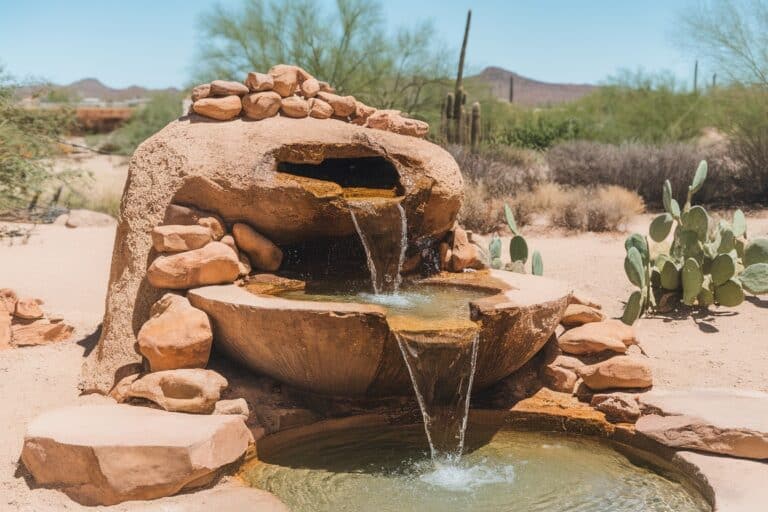11 Inspiring Mediterranean Garden Designs for Warm, Sunny Climates: Creative Ideas for Lush Outdoor Spaces
Dreaming of a relaxing retreat just outside your door? Mediterranean garden designs offer beautiful, low-maintenance spaces that thrive in warm, sunny climates.
These gardens celebrate sunlight, heat-tolerant plants, and outdoor living, turning any backyard into a welcoming escape.
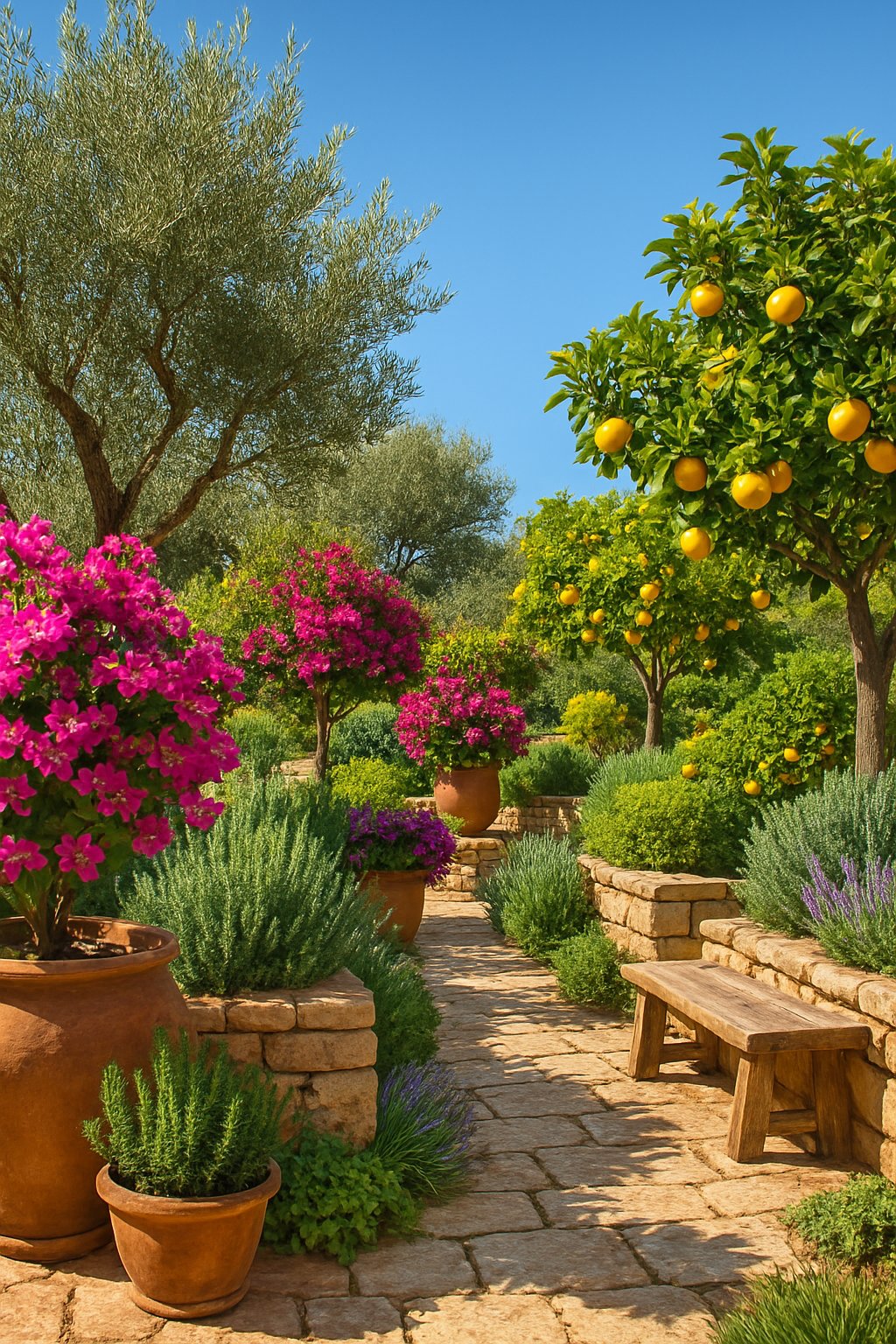
Gravel paths, sculptural succulents, and rustic outdoor dining areas echo the easygoing charm of southern Europe.
By playing with textures, colors, and plants like lavender and olive trees, this style brings warmth and a sense of timelessness to outdoor spaces.
If you’re searching for ways to refresh your garden, you’ll find plenty of simple ideas to capture that laid-back vibe.
For more design tips and inspiration, check out Mediterranean garden ideas that really shine in sunny spots.
What Defines a Mediterranean Garden
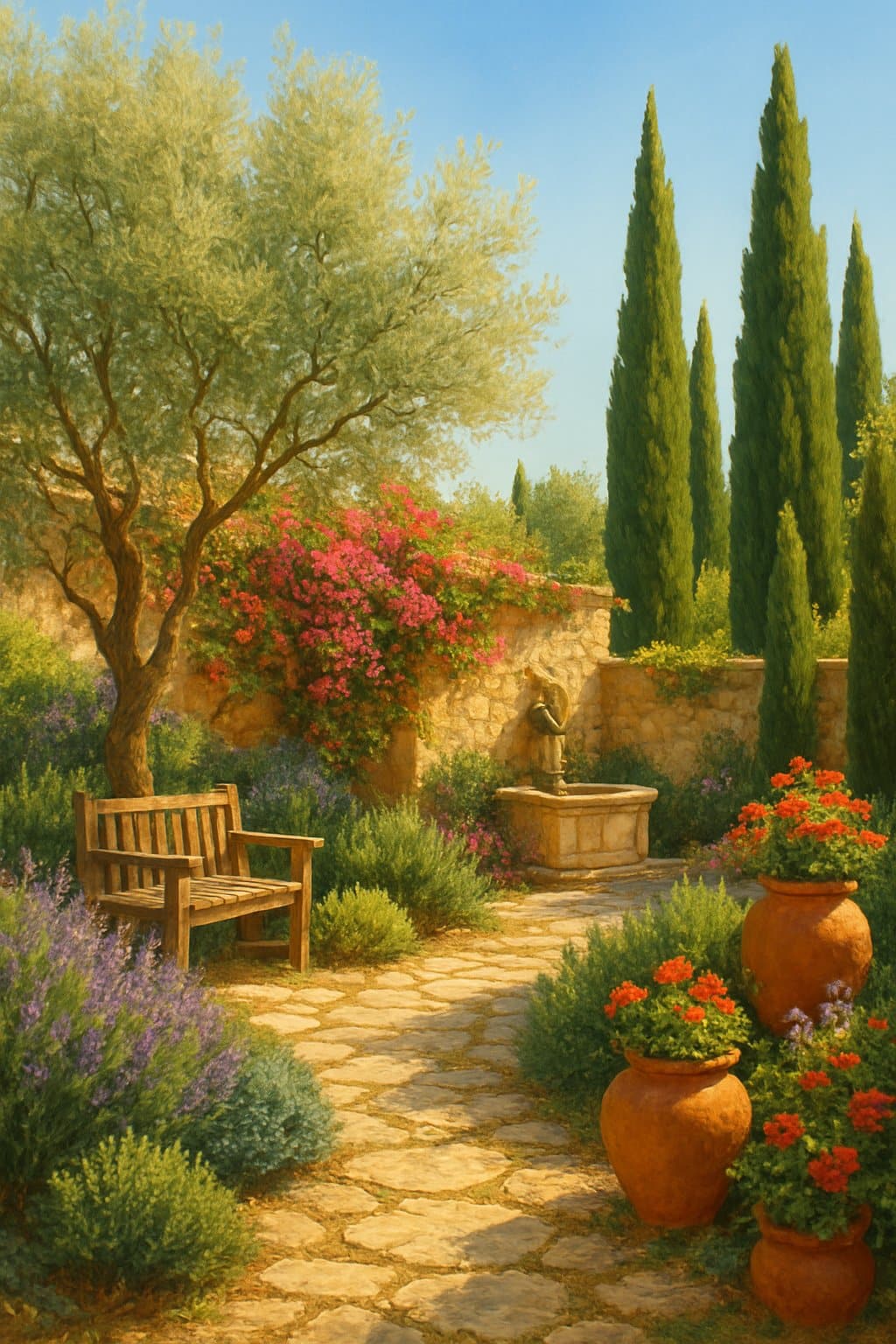
Mediterranean gardens invite you to live outdoors, blending lush greenery with rustic stone and practical layouts.
They highlight relaxation, old-world charm, and a surprising resilience in hot, dry weather.
Key Elements and Mediterranean Vibe
Mediterranean gardens lean on natural materials and simple shapes to create a welcoming atmosphere.
You’ll often spot:
Terracotta pots and tiles
Gravel or stone paths
Wrought iron furniture or accents
Water features like small fountains
Textured stone walls
Aromatic herbs like lavender, rosemary, and thyme cluster together for a classic feel.
Pergolas or carefully placed trees offer shade, and olive and citrus trees lend fresh scents and visual interest.
Earth tones and patterns in paving stones really set the mediterranean vibe.
Old-World Charm and Rustic Charm
Old-world charm? It comes from timeless elements and a sense of history.
Weathered wood, rough stone, and handmade pottery give every corner a rustic look.
Patios and stairs made from uneven stones feel cozy and lived-in.
Broken terracotta, chipped urns, and vintage lanterns add to the effect.
Tucked-away seating areas invite you to slow down and relax.
Soft, natural colors—sandy beige, terracotta red, olive green—blend right in with the landscape.
Cottage-style plantings and stone terraces turn the garden into a peaceful retreat.
Warm Climates and Drought Tolerance
Mediterranean gardens do best in warm, sunny climates where water isn’t always plentiful.
Gardeners pick plants that handle heat and dry spells with ease.
Drought-tolerant plants like olives, lavenders, and agaves are absolute staples.
Mulch and gravel help soil hold onto moisture and keep weeds at bay.
You’ll notice thick foliage, deep roots, and silvery leaves on many favorites.
Shady spots pop up under vine-covered pergolas or big trees—perfect for midday breaks.
Since water conservation matters, these gardens lean on natural rainfall and keep lawns to a minimum.
Grouping plants with similar water needs just makes sense, and it keeps everything looking healthy, even when the heat is relentless.
Plant Selection for Mediterranean Gardens
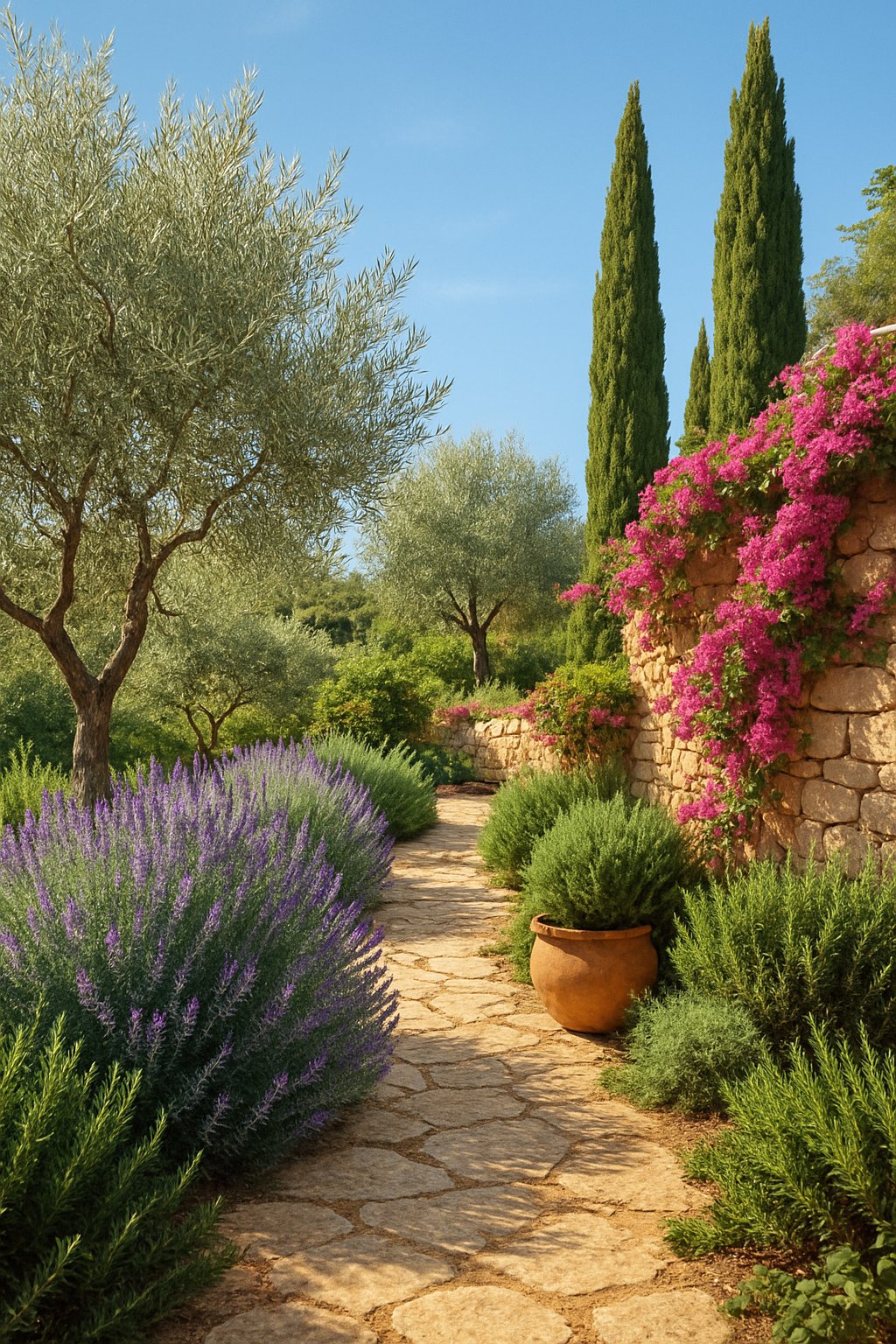
Choosing the right plants lets your Mediterranean garden thrive in sunny, dry weather.
A mix of aromatic herbs, elegant trees, and colorful flowers keeps things both beautiful and practical.
Drought-Tolerant and Aromatic Herbs
Aromatic, drought-tolerant herbs are the backbone of Mediterranean gardens.
Favorites like lavender, rosemary, thyme, and oregano shrug off heat and poor soil, filling the air with their scents.
Herbs such as santolina and sage add texture and even more fragrance.
Most of these herbs are evergreen, so the garden looks good year-round.
Once they settle in, they barely need any water—ideal for water-wise gardeners.
Aromatic herbs attract bees and butterflies, too.
Try planting them in borders, rock gardens, or tucked between paving stones for pops of color and scent.
Mediterranean Trees and Shrubs
Classic Mediterranean gardens mix evergreens and fruit trees for structure and shade.
Olive trees stand out with their twisted trunks and silvery leaves.
Citrus trees—think lemon, orange, mandarin—bring glossy leaves and bright fruit that feels almost festive.
Tall, slender cypress trees add strong vertical lines, making great windbreaks or natural fences.
Shrubs like myrtle, boxwood, arbutus, and phillyrea round out the mix.
These choices are all tough, drought-tolerant, and blend well with succulents and cacti, which need even less water and bring extra texture.
Vibrant Flowers and Fragrant Plants
Bright flowers bring Mediterranean gardens to life.
Hardy picks like agapanthus, salvias, and euphorbia take the heat and poor soil in stride.
Bulbs such as narcissus and anemones pop up each season with bursts of color.
For fragrance, star jasmine and common jasmine (with their sweet white or yellow blooms) fill the air all summer.
Fragrant roses and dianthus work well, too.
Succulents and small cacti pair nicely with these flowers, thriving in dry beds or containers.
If you want more plant ideas, Gardenia has some good suggestions for Mediterranean garden styles.
Creative Hardscape Design Ideas
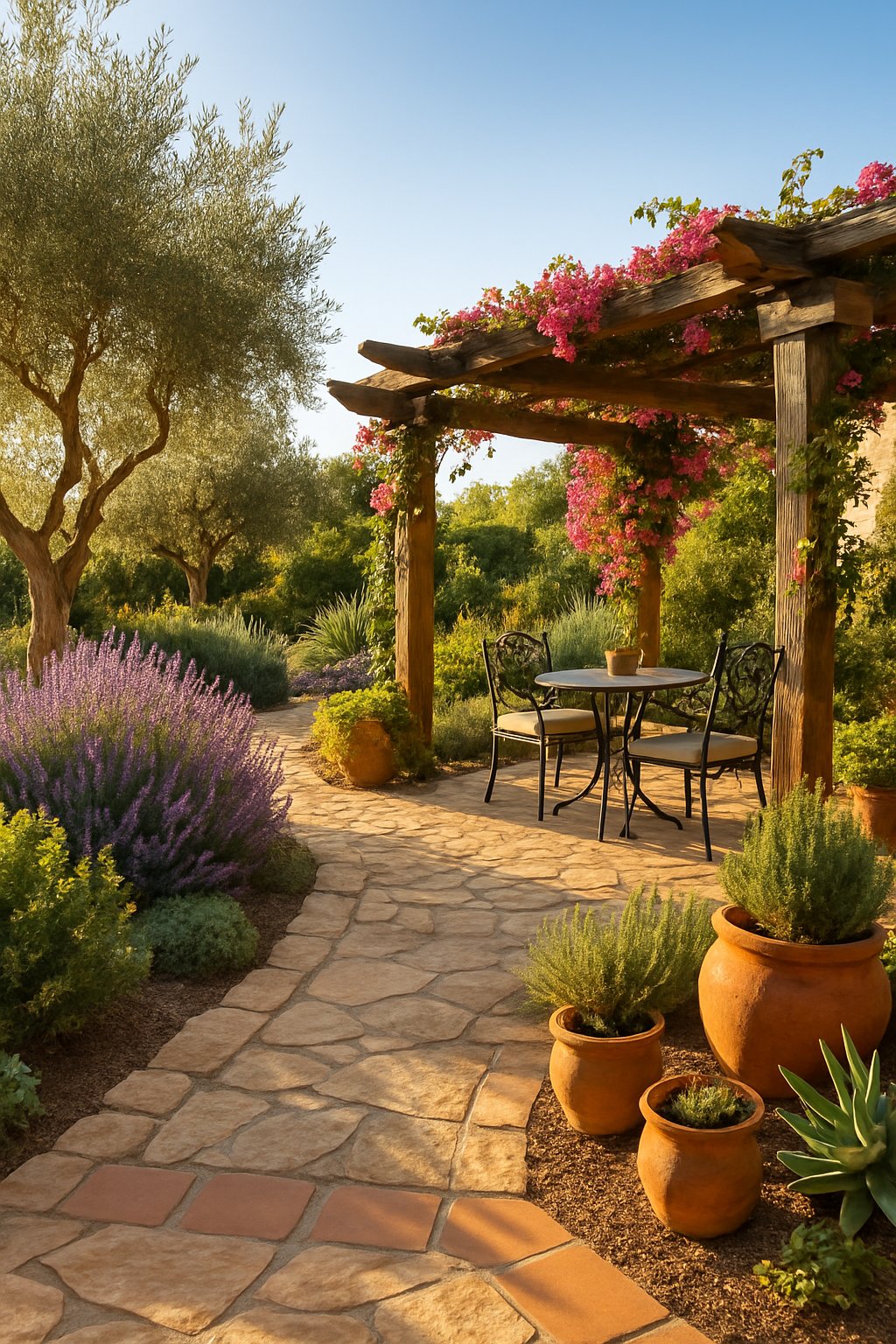
The right mix of textures and materials makes Mediterranean gardens feel alive.
Natural stones, bold pathways, and artistic touches come together to capture that outdoor charm.
Natural Stone Walls and Earthy Tones
Natural stone walls define garden spaces and blend in with the sun-drenched surroundings.
They often use warm, earthy tones—sandy beige, terracotta, or soft gray—that echo the local soil and plants.
Low stone walls can double as seating or raised beds, keeping things both open and cozy.
Dry-stacked stones are especially popular for their rustic look and good drainage.
Some folks mix smooth stone with rougher textures for a modern twist—it keeps things interesting without losing that relaxed Mediterranean vibe.
Topping walls with clay or stone tiles adds detail and helps them last longer in the weather.
Pathways, Mosaic Tiles, and Stone Pavers
Pathways guide you through Mediterranean gardens, whether you’re wandering or just heading for a shady seat.
Curved or winding stone pathways lined with pebbles, gravel, or mulch add movement and shape.
Irregular stone pavers create a natural, unfussy pattern underfoot.
Gaps between stones let herbs or low groundcovers peek through, softening the look.
Limestone, sandstone, or slate—materials that love the sun—bring classic Mediterranean charm.
Want a bit of artistry? Colorful mosaic tiles on steps or borders add flair.
Geometric, floral, or coastal designs turn plain areas into eye-catchers, and honestly, they don’t need much upkeep.
Accents and Sculptures
Accents like big urns, terracotta pots, or weathered benches grab your attention.
They look best tucked into corners or along paths, where they surprise you.
Traditional Mediterranean pottery often holds herbs or succulents, mixing beauty and practical use.
Garden sculptures—figures, stone spheres, or small fountains—draw the eye and create focal points among the greenery.
Whether you go classic or contemporary, a few artistic pieces give your garden personality.
Wrought iron gates or trellises frame views and give vines something to climb, adding to that relaxed, sophisticated Mediterranean atmosphere.
Incorporating Water Features for Tranquility
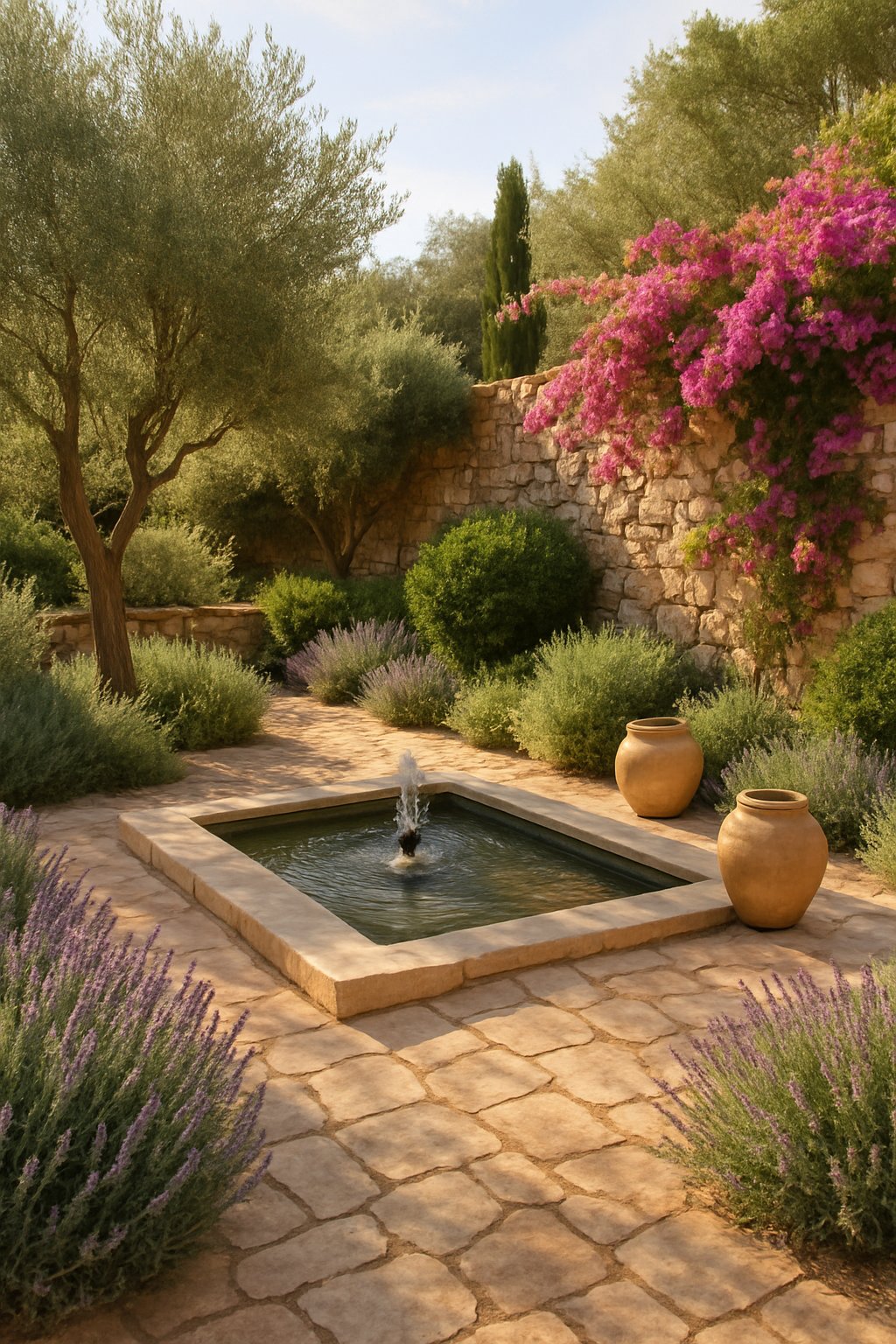
Water features bring a peaceful vibe to Mediterranean gardens, filling the air with gentle sounds and coolness.
With the right choices, even the sunniest garden feels more inviting and serene.
Fountains and Water Features
Gardeners often pick simple stone or ceramic fountains as a centerpiece in Mediterranean gardens.
The sound of bubbling or trickling water soothes the senses—who doesn’t love that?
Tiered fountains, wall fountains, and small ponds are all popular.
Natural stone, terracotta, and glazed ceramic keep things authentic.
Fountains usually go near seating areas or entryways, creating a calm focal point.
Even a small courtyard can fit a narrow wall fountain or birdbath.
Plants that love moisture, like mint or ferns, thrive around water features and keep the area lush.
A classic Mediterranean-style water feature adds a real sense of peace.
Looking for more ideas? Check out this guide on water features in Mediterranean gardens.
Why bother with water features?
- They cool things down
- The sound is calming
- Birds and wildlife show up
Courtyards and Calm Spaces
Courtyards are a Mediterranean staple, designed for privacy and quiet.
Usually, you’ll find a central water fountain, shaded seating, and potted plants.
Walls or hedges block wind and create a peaceful retreat.
Terracotta pots filled with fragrant herbs or small olive trees add beauty and shade.
The gentle sound of water from a fountain or basin just makes everything feel more tranquil.
Courtyard floors might be stone, tile, or gravel.
Some folks add colorful, hand-painted tiles to decorate water features, giving the space an artsy, layered look.
Benches or low chairs encourage you to linger—why rush?
For more inspiration, peek at these Mediterranean courtyard ideas.
Designing Outdoor Living and Dining Areas

Outdoor spaces in Mediterranean gardens are all about enjoying meals, hanging out with friends, and staying comfortable in the sun.
Design choices focus on inviting dining areas, plenty of shade, and relaxed seating made from rustic, natural materials.
Outdoor Dining and Alfresco Living
Mediterranean gardens usually feature cozy spots for outdoor dining and alfresco living. Stone or gravel patios keep their cool in the sun and clean up easily.
Picture a long dining table set under the open sky—it’s perfect for family meals or impromptu gatherings with friends. If you add rosemary or lavender nearby, you’ll get a gentle fragrance and a pop of color right where everyone’s sitting.
Wrought iron lanterns or string lights? They set the mood for those summer evenings. Large terracotta pots filled with herbs or citrus trees nearby not only boost the Mediterranean vibe, but they also add a bit of privacy.
Some folks go all-in with a rustic stone or brick oven for al fresco dining. Cooking and serving food outside somehow makes every meal feel a little more special. Keeping the transition between the kitchen and garden wide and open makes hauling dishes and platters a breeze.
If you want more ideas for arranging these spaces, check out these Mediterranean garden ideas.
Shaded Spaces and Pergola Ideas
Shade is absolutely crucial in hot, sunny climates if you want to relax outdoors. Building a pergola is a tried-and-true way to get some relief in a Mediterranean garden.
People build pergolas from wood, metal, or even stone, then let climbing plants like grapevines, jasmine, or bougainvillea take over. Before long, vines cover the structure, filtering sunlight and lowering the temperature underneath.
This means you can actually use your outdoor dining area at noon without melting. Some homeowners hang outdoor curtains or reed mats for extra cooling and privacy.
Pergola ideas range from simple, open frameworks to more elaborate designs with slatted or latticed tops. You can paint or stain the wood to fit your garden’s color scheme, but honestly, sometimes leaving it natural gives the best rustic charm.
A well-placed pergola really does extend how much time you’ll want to spend outside. For more inspiration, have a look at this Mediterranean garden guide.
Weathered Wood and Wooden Furniture
Wooden furniture is a staple in Mediterranean outdoor dining areas. It’s sturdy, comfortable, and just seems to fit the vibe.
Tables and chairs made from weathered wood look right at home, aging gracefully and picking up that soft, gray patina after a few seasons in the sun and rain. Benches, loungers, and low tables from reclaimed or untreated wood add a relaxed, lived-in feeling to the whole space.
Pick cushions and fabrics in natural shades—creams, blues, olives, terracottas. They’re comfy and, if you choose wisely, can handle a little weather.
To keep your wooden furniture going strong, oil or seal it once or twice a year. Some people skip the covers and let their pieces age naturally, which gives the garden more character over time.
For more ideas on styling outdoor furniture, check out this inspiring garden ideas page.
Container Gardening and Terracotta Inspiration
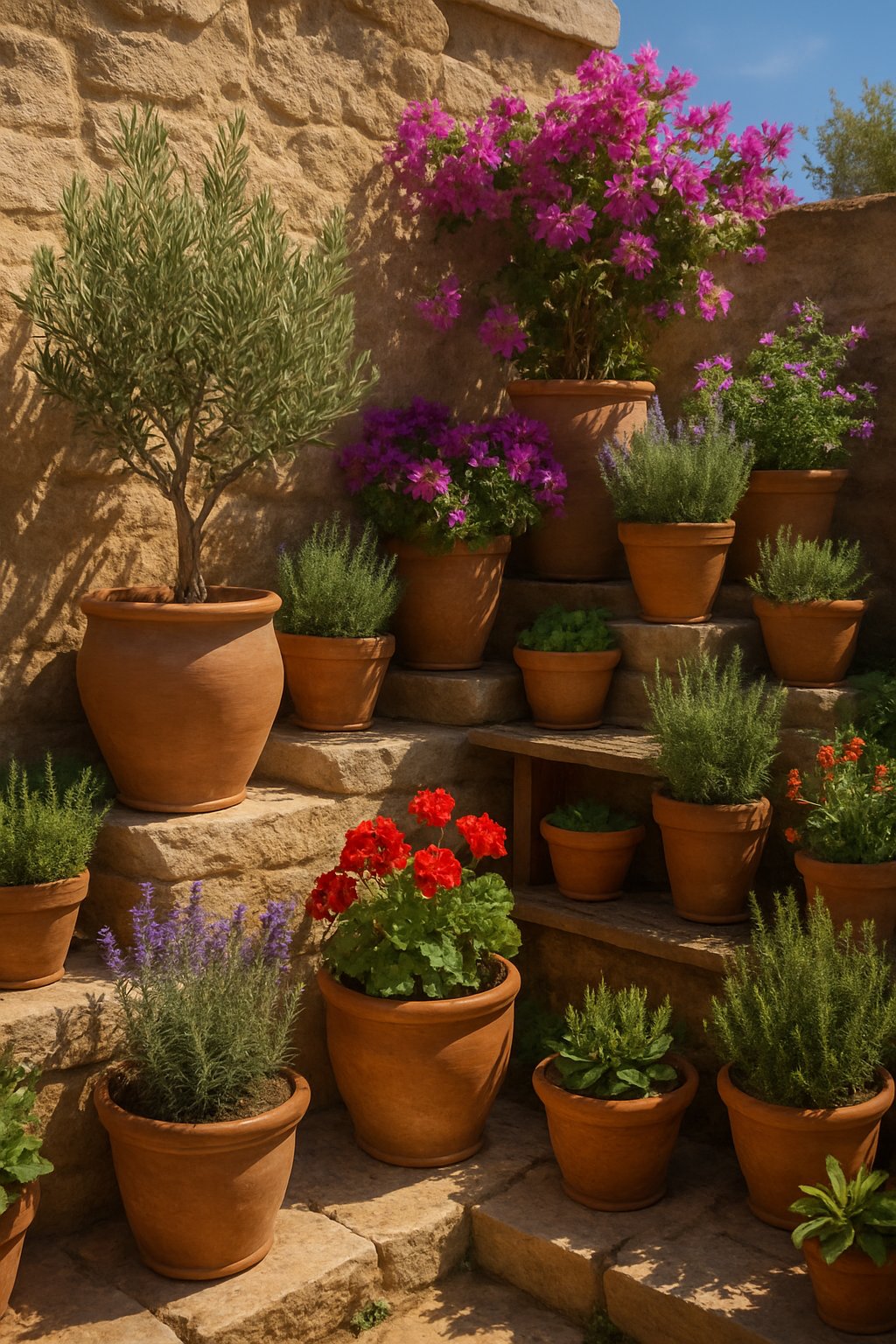
Mediterranean gardens use containers and terracotta to bring in color and classic appeal. These features let you tuck fragrant herbs, fruit trees, and bold shapes into sunny patios and courtyards.
Terracotta Pots, Urns, and Planters
Terracotta pots are everywhere in Mediterranean-style gardens. Their warm, earthy color pops against green leaves and helps keep plant roots cool when it’s blazing outside.
Classic urns and planters come in all sorts of shapes and sizes, making it easy to play with plant heights for extra interest. Place pots in little groups or line them along a path to draw the eye.
Mix tall urns with smaller dishes for variety. Terracotta works especially well with lavender, rosemary, and thyme, which love well-drained soil.
Common Mediterranean terracotta container shapes:
| Shape | Best Use |
|---|---|
| Urns | Statement pieces, entryways |
| Bowls | Herbs, succulents |
| Tall pots | Small trees, shrubs |
Terracotta’s weight means your pots won’t tip over in a breeze—practical, but still beautiful.
Potted Citrus Trees and Plants
Potted citrus trees just feel right in Mediterranean gardens. Lemons, oranges, and limes love full sun and do well in slightly oversized pots with good drainage.
You’ll need to water and feed them regularly during the growing season. Their glossy leaves and bright fruit add color and a fresh scent to patios.
For best results, pick containers with drainage holes and use a high-quality potting mix.
Gardeners often grow figs or olives in large planters, too. This makes it easy to fit edible plants into tight spaces and move them indoors if there’s a cold snap.
More inspiration? Try these Mediterranean container garden design ideas.
Care Tips for Potted Citrus:
- Place in direct sunlight (6-8 hours daily)
- Keep soil evenly moist, not soggy
- Fertilize in spring and summer
Oversized Pots and Container Gardening Ideas
Oversized pots can really steal the show. They hold multiple plants, small trees, or even a bold floral display.
Use them to decorate patios, frame entrances, or fill up those awkward corners that need a little life. Mixing plant heights and textures in one pot gives you a lush, layered effect.
For example, plant a small olive tree in the center, surround it with trailing rosemary, and toss in some annuals for color. Oversized terracotta planters work for both modern and classic tastes.
Mediterranean container gardening usually means picking drought-tolerant plants that can handle sun and heat—think agave, lavender, scented geraniums. Combining terracotta planters and large containers keeps things healthy and low-maintenance.
A bold pot can easily become the main feature in a small courtyard or balcony.
Paths, Courtyards, and Gravel Gardens

Gravel walkways and sun-drenched courtyards set the mood for a Mediterranean garden. They make upkeep simple and add loads of charm.
Stepping Stones and Gravel Pathways
Stepping stones over gravel make for relaxed, inviting paths. You can go with irregular slabs or neatly cut tiles, depending on your taste.
Lighter stones like limestone or sandstone usually suit the Mediterranean palette. If you leave wide gaps, low-growing herbs or moss can fill in and soften the look.
Gravel pathways are perfect for warm climates—they drain fast and feel nice underfoot, even if you’re barefoot. Borders of hedges, lavender, or rosemary add color and fragrance along the edges.
Winding informal paths break up big spaces and help the garden feel more natural and open.
Here are some popular materials for pathways:
| Material | Features |
|---|---|
| Crushed Gravel | Soft, good drainage |
| Flagstone | Natural, rustic look |
| Terracotta Tile | Warm, Mediterranean feel |
Gravel Gardens and Courtyard Design
A gravel garden saves water and nails that sun-baked Mediterranean style. These gardens often feature drought-tolerant plants like succulents, agave, and ornamental grasses.
Mixing gravel sizes, textures, and earth-toned colors creates visual depth and helps keep weeds down. Courtyards anchor the space and offer shady spots to gather.
Simple gravel courtyards can include posts for climbing bougainvillea, stone benches, or a small water feature. Arranging seating under the shade of olive or citrus trees makes hot afternoons a lot more bearable.
Winding paths connect the courtyard with garden beds or raised planters, making it easy to move through the space. Terracotta pots and clusters of local herbs like sage and thyme keep the courtyard feeling lively and useful.
Vertical Interest and Climbing Plants
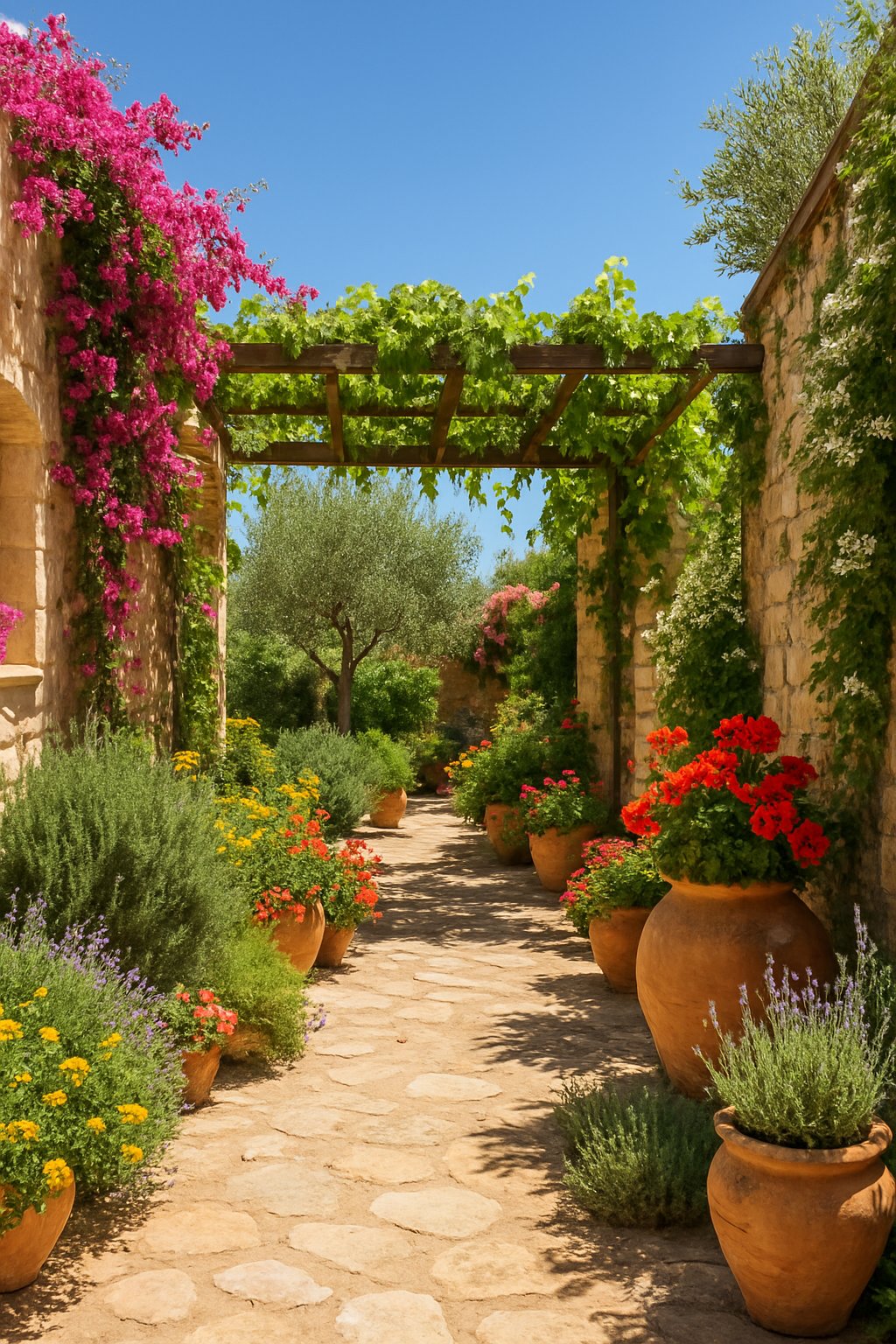
Mediterranean gardens really lean into vertical elements for drama and to save space. With the right climbing plants and structures, you can add color, texture, and height to a warm, sunny space.
Climbing Plants and Vines
Climbing plants and vines are a Mediterranean garden essential. They soften harsh walls, add privacy, and naturally draw the eye upward.
Some of the best picks? Bougainvillea, Jasmine, and Clematis. These thrive in sunny spots and handle dry spells just fine.
Many climbers bloom in bright colors, making them perfect for patios, courtyards, or entryways. If you want extra fragrance, try Star Jasmine or Honeysuckle.
Fast growers like Boston ivy can quickly cover big areas and keep things green most of the year. It’s smart to pick species that suit your climate for the best results.
A few quick tips:
- Support: Most climbers need something to grab—trellis, netting, you name it.
- Pruning: Regular trims keep them from going wild.
- Sunlight: Full sun usually means better growth.
For more ideas, here’s a handy list of climbing plants for Mediterranean gardens.
Arbors, Pergolas, and Trellises
Structures like arbors, pergolas, and trellises give climbing plants a place to shine. These elements add shade and shape to the garden.
A pergola covered with vines gives real relief from the sun. Arbors frame doorways or walkways, creating a welcoming entrance wrapped in flowers and leaves.
Trellises are flexible and can go against fences, walls, or stand alone as screens. Wood is a classic choice for a natural look, but metal works for modern spaces.
Paint or stain can help these features blend in or stand out. For design ideas, check out these Mediterranean garden ideas.
Grapevines and Climbers
Grapevines are iconic in Mediterranean gardens. They’re beautiful and practical—those broad leaves and twisting stems provide shade and a sense of place.
Train grapevines over a pergola for a leafy canopy. You’ll get a cool retreat in summer, and once the leaves drop, more sun in winter.
Grapevines are tough and love full sun with well-drained soil. Other great climbers include Wisteria and Roses—they bring blooms and fragrance all season long.
A mix of vines gives longer flowering and a fuller look. For ideas on using grapevines and other climbers, check out this guide to Mediterranean climbing plants.
Creating Texture, Color, and Lush Greenery
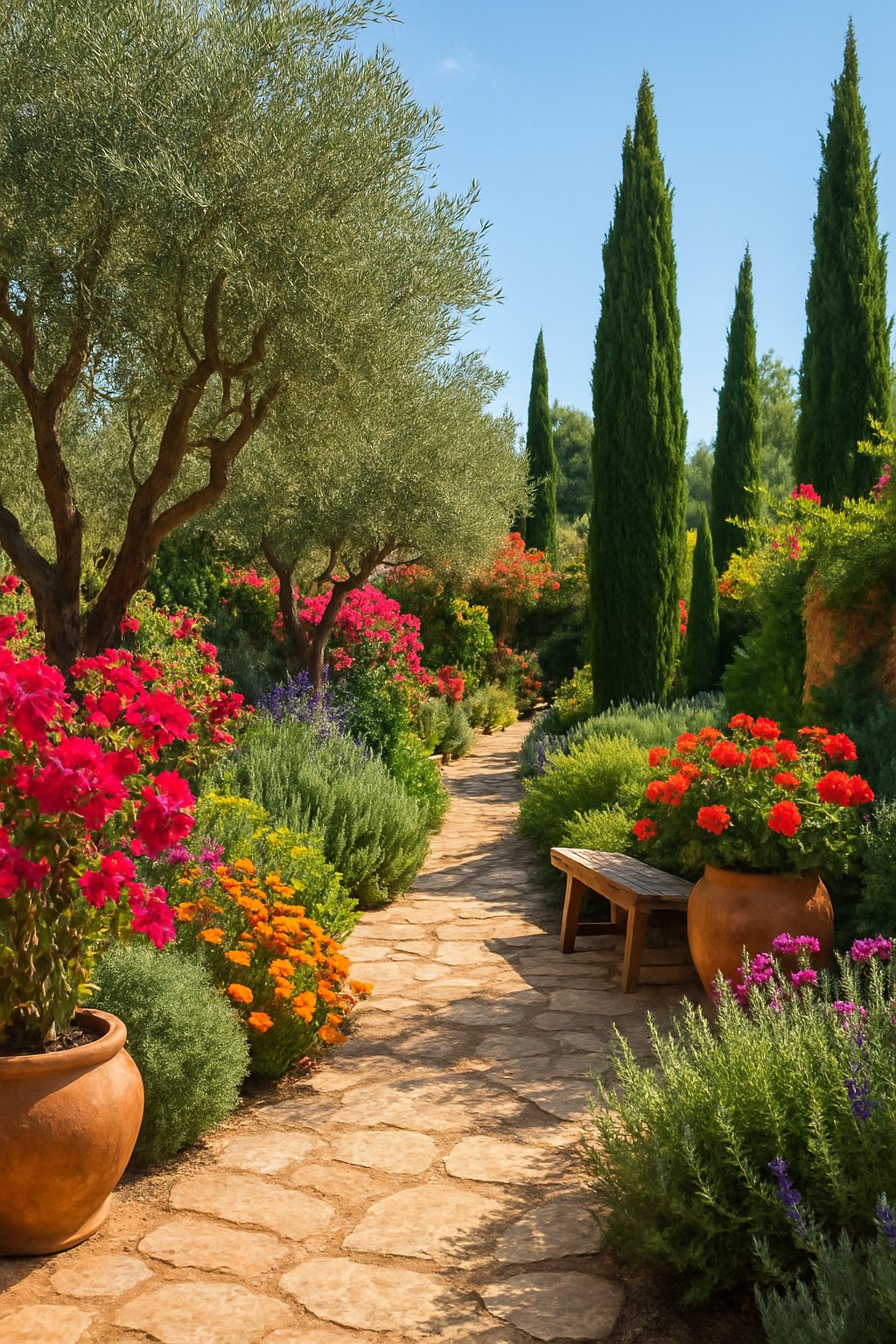
Mediterranean gardens really come alive with layers of texture, bold colors, and lush plants. Picking and placing the right plants makes a space feel genuinely welcoming and full of life.
Lush Greenery and Vibrant Colors
Mediterranean gardens thrive on lush greenery. Rosemary, lavender, and myrtle show off dense foliage that stays fresh, even when the weather gets hot and dry.
Citrus trees—think lemon and orange—bring those glossy green leaves and bright fruits. They add shade and a playful burst of color.
Palms and olive trees shoot up, mixing up the heights and making the garden feel layered and interesting.
Bold colors matter here, too. Red, orange, and yellow flowers like geraniums or marigolds liven up the space.
Climbing jasmine or bougainvillea can sprawl over walls or archways. Besides the color, they add a whiff of fragrance that makes every corner feel special. If you want your yard to feel like a true Mediterranean garden oasis, these plants are a good start.
Textures, Repeat Planting, and Vibrant Plants
Mediterranean gardens stand out because of their textures. Try mixing spiky agave or aloe with the soft leaves of lavender and the fine needles of rosemary.
Tables and walkways surrounded by stone, gravel, or mulch give your feet something interesting and keep things neat.
Repeat planting also plays a big part. Arrange the same vibrant plants along paths or borders to create a sense of rhythm.
Hardy plants like agave and succulents, with their bold shapes, bring visual interest and barely need any water or fuss. Perfect for warm, sunny climates.
Want a cheat sheet? Here are some elements to include:
- Palms or olive trees for height
- Lavender, rosemary, and myrtle for lush green texture
- Citrus trees and bougainvillea for color
- Stone or gravel for ground texture
- Repeat planting for harmony
Herb Gardens and Edible Features
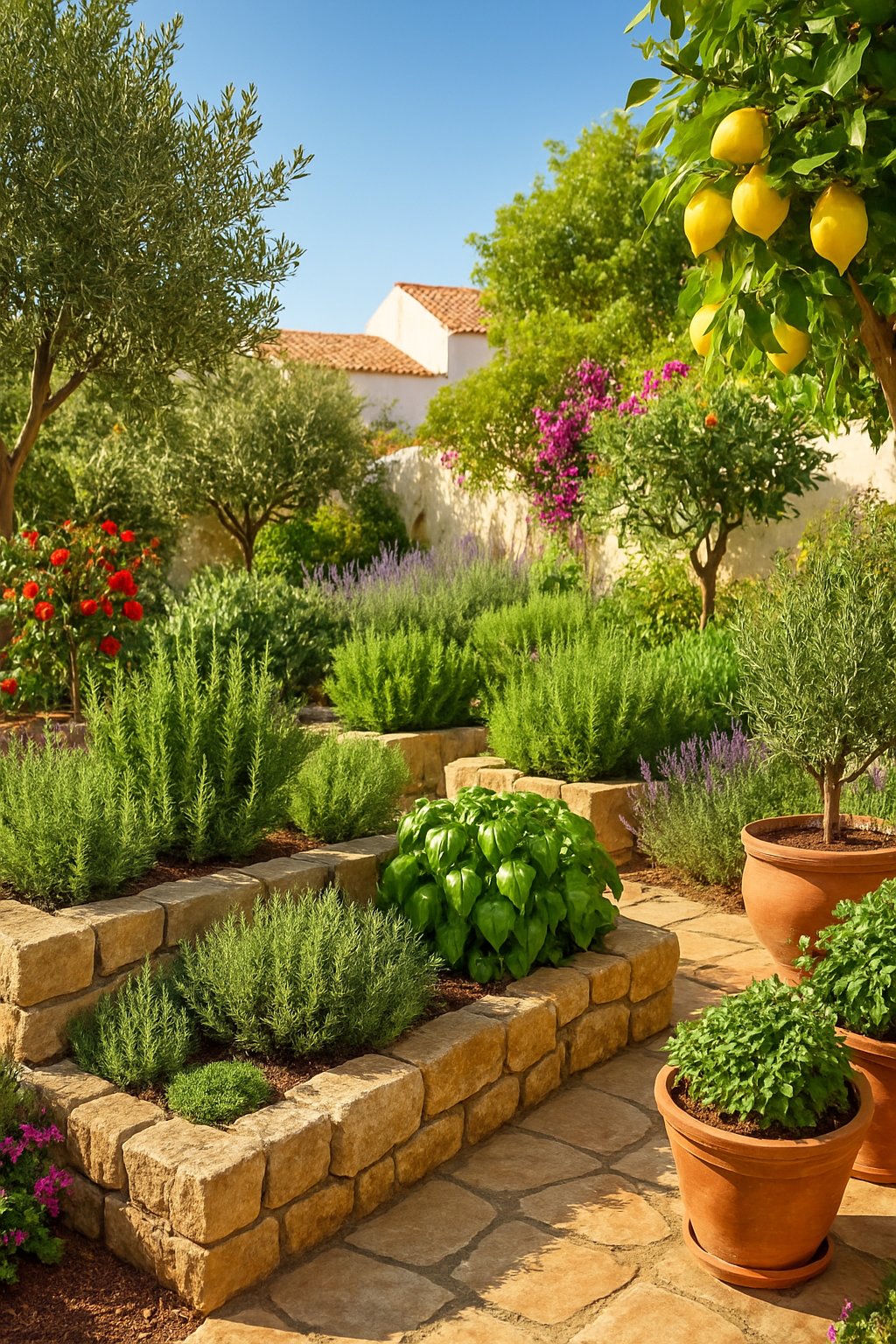
Mediterranean gardens love combining fragrant herbs and edible plants. These add color, texture, and honestly, who doesn’t want to grab dinner straight from the garden?
Herb Gardens and Outdoor Kitchens
Herb gardens are a staple in this style. Rosemary, thyme, oregano, lavender, and sage all thrive in sunny spots and, once they’re settled in, barely need water.
Short brick walls or terracotta pots help keep herbs tidy and within reach.
Many gardeners plant herbs right by patios or outdoor kitchens. That way, you can snip off fresh leaves while cooking or eating outside.
Some patios have built-in planters or raised beds near where people sit. An outdoor kitchen next to a herb garden just makes the space feel relaxed and practical for al fresco meals. For more on herb gardens in Mediterranean yards, check out this guide.
Integrating Mediterranean Vegetables and Edibles
Veggies like tomatoes, eggplants, and peppers grow happily alongside flowers in Mediterranean gardens. They love full sun and do well in raised beds or containers.
Figs, grapes, and olives are classic picks that offer both shade and beauty. Lining paths or borders with leafy greens or artichokes blurs the line between food and ornamentals.
Vertical trellises for beans or cucumbers help save space and add a little height. Small fruit trees in big pots or baskets of fresh produce on the table make the space feel welcoming. There are lots of ideas for edible features in Mediterranean gardens out there.
Mediterranean Garden Lifestyle Inspiration

A Mediterranean garden isn’t just about plants or pretty décor. It’s about easy outdoor living—moments spent together, whether you’re relaxing under a shaded patio or sharing a meal with friends.
Relaxation, Alfresco Activities, and Entertaining
These gardens invite relaxation and social time. Shaded seating—under a pergola or beside a stone wall—makes it comfortable even on sunny days.
You might read, nap, or just chat for hours outside.
Spaces often revolve around alfresco dining. Big tables, surrounded by terracotta pots and aromatic herbs, make it easy to gather friends or family.
Meals don’t have to be fancy—sometimes it’s just olives and bread, other times there’s grilled food and local wine.
Outdoor kitchens, fire pits, and pizza ovens help set the mood. Gravel or brick paths connect everything, so you can wander from one spot to the next. Soft lighting—lanterns or string lights—keeps the evenings cozy. For tips on arranging seating and dining, these Mediterranean garden ideas are worth a look.
Capturing the Mediterranean Lifestyle
The Mediterranean lifestyle invites you to slow down, connect, and soak in nature. Picture gardens filled with aromatic plants—lavender, rosemary, thyme—so you catch their scent as you relax or share a meal outside.
You’ll often spot a small fountain or birdbath, which brings a gentle soundtrack and a few feathered visitors. Some folks tuck in lemon or fig trees, making it easy to grab fresh fruit right from the branch.
Textiles pop up everywhere: think colorful cushions tossed on chairs or a bright table runner that feels both relaxed and a little festive. There’s a real charm to the simple, rustic decor—traditional tiles, pottery, maybe a bit of weathered wood that’s seen some sun.
Honestly, walking barefoot on cool stone or lingering over food outdoors just feels right. If this vibe speaks to you, check out more creative ideas for a Mediterranean garden setting and see where it takes you.




